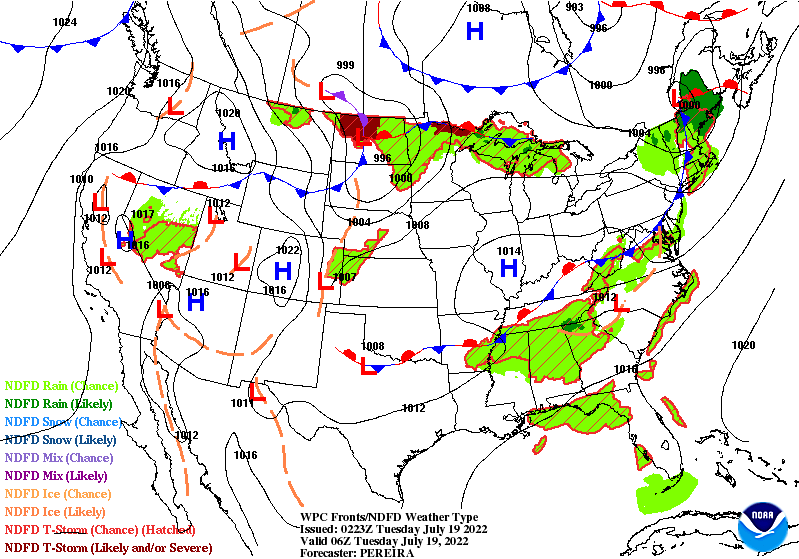Here is what we are paying attention to this evening and the next 48 hours from this evening’s NWS Forecast.
...Record Breaking Heat to continue into mid week across the Central and Southern Plains... ...Severe Thunderstorms possible from portions of the Northern Plain into the Upper Great Lakes... ...Monsoonal showers to bring locally heavy rains and isolated Flash Flooding across portions of the Southwest, Great Basin and Southern Rockies... ...A Fire Weather threat will stretch from the Northern Rockies into the Northern Great Basin and Central High Plains...
Continuation of the NWS Short Range Forecast (It is updated twice a day and these updates can be found here.
No big changes expected over the next few days to the position of the persistent mid to upper level closed high that stretches from the Southwest into the Southern Plains. This closed high will continue to produce above average temperatures across much of the western to central U.S. over the next few days, with the core of the greatest high temperature anomalies stretching across the Central to Southern Plains. Numerous record high temperatures are possible Tuesday from western Kansas, southward through much of Oklahoma, Texas, New Mexico and western Arkansas. A cold front sinking southward through the Central Plains on Wednesday will bring slight cooling to this region, but the record heat will continue farther to the south across much of Texas into northern Louisiana. Heat advisories and excessive heat warnings currently stretch across much of the Plains, the central Valley of California and portions of Arizona, affecting nearly 40 million people as of Monday afternoon. The above mentioned cold front that brings some relief to the record high temperatures over the next few days over the Northern and Central Plains will also be responsible for thunderstorms that will bring the potential for severe weather, heavy rains and isolated flooding from portions of the Northern Plains, eastward into the Upper Mississippi Valley and Upper Great Lakes. Dry conditions and gusty winds in the wake of the front pushing through the Northern to Central Plains will keep an elevated fire weather threat over the next few days across portions of the Northern Rockies, Northern Great Basin and into the Central High Plains. Scattered monsoonal showers and thunderstorms are also expected over the next few days from the Southwest into the Southern Great Basin and Southern Rockies around the peripheries of the closed upper high centered from the Southwest into the Southern Plains. These storms may produce locally heavy rains, leading to isolated flash flooding. Across the East, thunderstorms may affect the major metro areas from Washington to Boston late Monday afternoon into evening, bringing locally heavy rains and isolated flash flooding. More widespread heavy rains possible this evening into Monday night from far northern NY State into northern New England. Recent dry conditions across these areas has resulted in low stream flows and should decrease any flooding risk.
Maps that relate the forecast to geography can be found by clicking Here for Day 1 and Here for Day 2.
Here is a 60-hour animated forecast map that shows how the short-term forecast is expected to play out.
HAZARDS OUTLOOKS
Click here for the latest complete Day 3 -7 Hazards forecast which updates only on weekdays. Once a week probably Monday or Tuesday I will update the images. I provided the link for reads to get daily updates on weekdays. Use your own judgment to decide if you need to update these images.
Worldwide Tropical Forecast
(This graphic updates on Tuesdays) If it has not been updated, you can get the update by clicking here https://www.cpc.ncep.noaa.gov/products/precip/CWlink/ghazards/images/gth_small.png
Detailed Maps and Reports for the Western Atlantic and the Pacific Oceans
Below are three maps that summarize the situation for the Atlantic, Eastern and Central Pacific. Additional information can be accessed by clicking HERE
First the Atlantic
Click to view the forecast map and have access to additional information https://www.nhc.noaa.gov/gtwo.php?basin=atlc&fdays=5
Then Eastern Pacific
Click to view the forecast map and have access to additional information https://www.nhc.noaa.gov/gtwo.php?basin=epac&fdays=5
Then Central Pacific
Click to view the forecast map and have access to additional information https://www.nhc.noaa.gov/gtwo.php?basin=cpac&fdays=5
And the Western Pacific
Click to view the forecast map and have access to additional information https://www.metoc.navy.mil/jtwc/jtwc.html
Some Intermediate-Term Outlooks
Links to “Outlook” maps and discussions for three time periods. Days 6 – 10, Days 8 – 14, and Weeks 3 and 4. An outlook differs from a forecast based on how NOAA uses these terms in that an “outlook” presents information from deviation from normal and the likelihood of these deviations.
You have to click on the links because they do not update automatically and I do not want to have stale images in the article. But it is not difficult to click on a link and you get a large image plus a discussion. On Fridays in a separate article, we will show the images and provide a link in this article that article. But remember what you will see is the images as of Friday. But here you can get the current images simply by clicking on them. Then hit the return arrow at the upper left of your screen to return to the article. You will not find this information easily anywhere else.
Right now you can find these maps here (We show them every Friday there but you can click above and find them).
Month to Date Information
Temperature
Precipitation
Month to date Temperature can be found at https://hprcc.unl.edu/products/maps/acis/MonthTDeptUS.png
Month to date Precipitation can be found at https://hprcc.unl.edu/products/maps/acis/MonthPNormUS.png






